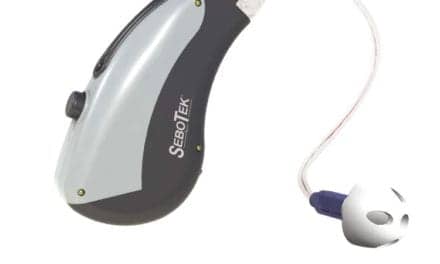Suzanne talks about her new book, Eddie the Elephant’s Magical Ear, and what life is like for her as a professional living with binaural cochlear implants
By Kathryn Sutherland
Eddie the Elephant’s Magical Ear is the story of Eddie, an endearing and adventurous elephant whose day is turned upside down when he breaks and loses his ear and discovers he can no longer hear! With the help of an itsy-bitsy spider and a magical hearing aid, Eddie goes on an unexpected journey to get his ear (and hearing) back. Eddie the Elephant’s Magical Ear is a charming and imaginative book with fun illustrations for both children and adults with hearing loss and for those who recently obtained or are curious about others with hearing aids. When Eddie tells of his adventure, he is delighted with his journey and the delight associated with his magical hearing aid as spotlighted with his glee to hear.
Kathryn Sutherland: Why did you decide to write a children’s book?
Suzanne Picerno: It was so interesting, Kathryn. I have three books that I am in the process of writing, and one is more complex, and I’ve been struggling to write it. And so, I’m sitting there, and, in my head, I heard, “Eddie is an elephant.” And then the voice said, “He’s not a big elephant.” And I’m like, “All right, and it’s not a small elephant.” I put aside the outline I was working on for the more technical book. And I said, “I think I’m going to be writing a different book than I planned.”
Sutherland: That is such an interesting story; please share more.
Picerno: I wrote the first iteration in 20 minutes, and I finished seven months later. The book wrote itself in terms of what it wanted to say. And then getting it to say it in a way that made sense, in a way that spoke to people, came out of it. My thought was if I could take something complex and turn it into something very simple that was fun to read on an unconscious level for adults, they might get it. And children would learn in an exciting and fun way through inventive pictures and rhymes, and here’s this elephant that loves to hear sounds.
And the spider is this little itsy-bitsy thing that you would think, “Small things don’t matter.” Well, small things do matter. And I know, in my experience being deaf, there are times when I still feel a lot of pain and anguish, and people tell me, “I don’t want to hear about hearing, Suzanne.” Or I visit my mother at her retirement community, and she says, “Don’t talk about hearing. Don’t talk about hearing aids.” I’m like, “Why am I even here?” because it’s who I am.
Sutherland: Would you please share your own story of hearing loss with our readers?
Picerno: I started losing my hearing when I was 12, but it was just a mild loss, and I didn’t start wearing hearing aids until I was 25. My loss was genetic, so I knew in my 20s that I would go deaf; it took 30 years. I cried every day over my hearing because I had anxiety, I was afraid, and I couldn’t hear. I had the Bluetooth phone, but deaf people, we’re still terrified of the phone for the most part. I’m only now becoming comfortable with the phone because I have binaural cochlear implants. And it’s made a world of difference for me, but I was terrified of the phone. I had a very well-established career, but I worked my way down the ladder, so to speak.
Years later, I learned that the things I did to compensate for my hearing loss at work were interpreted as incompetence or insubordination because I didn’t use the phone. Other people have conversations about the status of a project, often verbally, over the phone. At a social gathering with your clients and you tap them on the shoulder because you want to get their attention, because you want to see their faces, so you can see what they’re saying. Well, it is inappropriate in today’s culture to touch your clients.
Sutherland: Yes, I never thought about that, Suzanne. You’re right. It sounds like you have a wealth of information to share about the unique needs of people with hearing loss in the workplace.
Picerno: This is something I do want to write a book about; I want to educate people in the workforce that you can be severely hearing impaired and be successful. It must be done differently. It’s not just getting a Bluetooth phone; it’s not physical accommodation. It’s also social accommodation. It’s getting the job, sitting down with HR and your supervisor, and saying, “Here are the behaviors that hearing impaired people do.”
For example, we talk too loudly when the noise gets loud; we’re going to speak louder because we’re trying to hear ourselves through bone conduction. This intensifies at a social gatherings and with alcohol consumption, people tend to talk louder. And it’s going to be perceived that we’re yelling or that you are intoxicated.
Sutherland: Has that happened to you personally?
Picerno: Yes, it has, and I isolated myself. It was just a whole lot of things that I did. And when I looked back at it objectively, and now that I have the experience of being a hearing instrument specialist and seeing what my patients do, I realized that there were dots put together and that it could be done differently.
I’m also working with other companies, like Hi There Solutions, which is an excellent app.; it’s like FaceTime for the hard of hearing and the deaf. It’s real-time captions and ASL emojis. It’s incredible.
Sutherland: Thank you for joining me today and thank you for sharing your story. I hope we can visit again in the future.
Picerno: Thank you, Kathryn.

Suzanne Picerno is a former corporate professional, who lost her hearing over a 30 year period. From hearing aid wearer to becoming functionally deaf, she is an example of what can be achieved despite the appearance of obstacles. Today, Suzanne has bilateral cochlear implants and is a passionate advocate for creating hearing awareness. She has an MA in clinical psychology, an MBA, and is a licensed hearing aid specialist.





